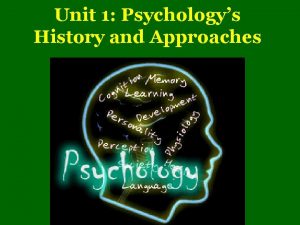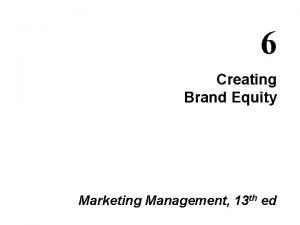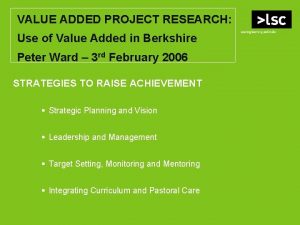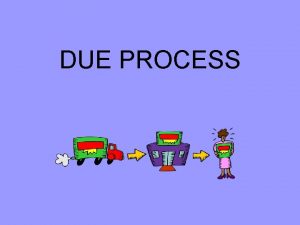History and Approaches Day 1 added from due






























- Slides: 30

History and Approaches Day 1 added from due to possible weather next class.

https: //www. youtube. com/watch? v=_dyv. Xcv 3 ej 0 What’s my name? Why does psychology sometimes get disrespected? In your opinion who is the most famous psychologist? If this person is the “face of psychology” does that result in a greater or reduced respect of the field? explain Do you feel psychological studies can serve as powerful evidence? Who is the most influential psychologists?

A. P. Objectives I can describe and compare different theoretical approaches in explaining behavior I can recognize the strengths and limitations of applying theories to explain behavior I can identify major historical figures in psychology

A. P. Psychology Assignment 4: History and Approaches pages 3 -5, 7 -14 1. In your on words and on another piece of paper or on note cards identify the following terms and names: 2. Describe and compare the different theoretical approaches taken by structuralism and functionalism, in explaining behavior. 3. Connect the debate between Structuralism and Functionalism to one or more of Psychology’s biggest questions located on page 6. 4. Develop a list of questions that each school of thought might ask. 5. Norah is a 6 year old girl who is often disobedient. She frequently throws temper tantrums and refuses to finish her meals. Her parents go to a well-respected psychologist. How would the psychologist explain Norah’s behavior if they were a: Humanist? Behaviorist? Psychoanalyst? Cognitivist?

An Experiment in Introspection

Wilhelm Wundt, known as the father of modern scientific psychology, opened the first lab to study human behavior in 1879. Wundt and his followers relied heavily upon introspection as a technique to analyze experiences. Subjects were exposed to an experience and asked to relate their thoughts, feelings, and images evoked by the event. Most experiences were either sensory or perceptual. Read the questions and write about this sensory experience. . . 1. What is the color of your candy? 2. Did you choose your piece based in the color? Why? 3. Place the candy in your mouth. Describe the flavor of the candy. 4. What images or memories does the candy evoke? 5. Does the taste diminish the longer the candy stays in your mouth? If so, why do you think this happens? 6. Describe the texture of the candy. 7. Does the texture change as the size diminished? 8. Bite the candy describe the sensation. 9. What happens to your teeth as you chew the candy? 10. What other senses are involved and how?

What do you see as a benefit to introspection? What would be a criticism? Is introspection science? See history and approaches powerpoint

There is a lot of overlap https: //www. simplypsychology. org/perspective. html

Get into pose of the photograph Introduce yourself Name What is the name of the Perspective on psychology that you represent? What are some of the key assumptions that you and other from your perspective have on psychology? What methods do you follow? And a quote You and your group should be prepared to answer questions and address criticisms of your approach You can answer the questions or ask your students (the group) to answer the questions.

Sigmund Freud psychodynamic

B. F. Skinner Behaviorism

Carl Rodgers Humanist

Jean Piaget Cognitive

Albert Bandura Social Psychologist

Leon Festinger Cognitive

Explain how Behaviorism may be interpreted as a response to the psychodynamic perspective. Behaviorism takes use the scientific approach Experiments that can be replicated and proven false Explain how humanism may be interpreted as a response to both the psychodynamic perspective and behaviorism. Psychodynamic and Behaviorism reduce human behavior in very small components. Humanism takes a much more holistic view. Humanist also take more a growth mindset

Evolutionary psychology 1. You are on a boat that overturns. It contains your 5 -year-old and 1 -year-old children (of the same sex). The boat sinks and you can save only one. Whom do you choose to save? Circle one: 5 -year-old 1 -year-old 2. That same boat (you are slow to learn lessons) contains your 40 -year-old and 20 -year-old children (both of the same sex). Neither can swim. As the boat sinks, whom do you choose to save? Circle one: 40 -year-old 20 -year-old 3. Would you rather marry (or have you married) someone older or younger than yourself? Circle one: Older younger 4. Of the following six, which three are most important in the selection of your mate? Circle the answers: a. good financial prospects b. good looks c. a caring and responsible personality d. physical attractiveness e. ambition and industriousness f. an exciting personality

Evolutionary psychology 5. You and your spouse are the proud parents of a new child. The grandparents are ecstatic. Who do you think will be kinder to the child? Circle one: the mother of the mother 6. the mother of the father Who will mourn more at the death of a child? Circle the answer in each pair: a. Father b. parents of the father c. younger parents mother parents of the mother older parents 7. Which will elicit more grief? Circle the answer in each pair: a. death of a son b. death of an unhealthy child death of a daughter death of a healthy child

Evolutionary psychology 1. You are on a boat that overturns. It contains your 5 -year-old and 1 -year-old children (of the same sex). The boat sinks and you can save only one. Whom do you choose to save? Circle one: 5 -year-old 1 -year-old 2. That same boat (you are slow to learn lessons) contains your 40 -year-old and 20 -year-old children (both of the same sex). Neither can swim. As the boat sinks, whom do you choose to save? Circle one: 40 -year-old 20 -year-old 3. Would you rather marry (or have you married) someone older or younger than yourself? Circle one: Older (expected answer by female) younger (expected answer by male) 4. Of the following six, which three are most important in the selection of your mate? Circle the answers: a. good financial prospects (expected answer by female) b. good looks (expected answer by male) c. a caring and responsible personality (expected answer by female) d. physical attractiveness e. ambition and industriousness an exciting personality (expected answer by male) (expected answer by female) (expected answer by male) What are your theories?

Evolutionary psychology 5. You and your spouse are the proud parents of a new child. The grandparents are ecstatic. Who do you think will be kinder to the child? Circle one: the mother of the mother 6. the mother of the father Who will mourn more at the death of a child? Circle the answer in each pair: a. Father b. parents of the father c. younger parents mother parents of the mother older parents 7. Which will elicit more grief? Circle the answer in each pair: a. death of a son b. death of an unhealthy child death of a daughter death of a healthy child What are your theories?

According to evolutionary psychologists, all organisms, including humans, are "gene producing machines" with the basic motivation of perpetuating their own genetic pool. In short, our genes predispose us to act in ways that enhance their chances of surviving and spreading. This fundamental motive underlies all our behavior. In response to questions 1 and 2, respondents are more likely to choose the 5 year old and 20 year old, respectively. Why? As Weiner explains, because some children die between ages 1 and 5, and 5 year olds are therefore more likely to reproduce, saving the older child would be more likely to perpetuate the genetic pool. Similarly, a 20 year old is more likely to reproduce than is a 40 year old. Ultimately, it is mating that perpetuates the genetic pool. For the female, reproductive capacities are limited to approximately 25 children. For males, reproductive potential is almost limitless. Because of the female's greater investment in each child, she must be careful to select a mate who will help her in child rearing. The male must simply choose females who can bear children. In response to question 3, it follows that females should prefer to mate with older males, because they have more resources to help in child care. Males should prefer younger females because they are more likely to give birth. In response to question 4, females should select items a, c, and e, which concern resources, caring, and responsibility, whereas males should select items b, d, and f, which relate to sexual preoccupations. Females have the advantage of knowing that any child they bear is theirs. The male must determine that the female has really borne his child. Thus, in response to question 5, the maternal grandparents, assured of 25 percent genetic carryover, should be especially happy. The greater the investment in a child and the more likely that child is to reproduce, the greater the experienced negative emotion at death. Thus, in response to question 6, greater grief should be experienced by the mother, parents of the mother, and older parents (who are less likely to reproduce again); in response to question 7, grief is greatest for the death of a healthy male child. Weiner, B. (1992). Human motivation: Metaphors, theories, and research. Newbury Park, CA: Sage Publications.

Using Psychological Perspectives to Answer Questions on Behavior.




Use the biopsychosocial model to explain memory

Module 2 Student Activity: Illustrating Psychology’s Complementary Perspectives: The Case of Andrea Yates https: //www. youtube. com/watch? v=Tb. OKv. Zd. LWb. Y

Determine take Biopsychosocial approach in explaining Andrea’s actions. Categorized the various facts of the case. BB- biological bases P- Psychological Reports claim Andrea suffered from low self-esteem S- Social She believed that her children weren’t developing correctly and drowning them was the only way to save them from hell. Andrea was diagnosed with a mood disorder Andrea’s brother and sister were also on antidepressants. Andrea’s extended family rarely visited or helped her out with the kids. Andrea’s doctors took her off medication. Andrea was diagnosed with postpartum depression with psychosis, she had been taken off her antipsychotic medication about a month before her children’s deaths. Andrea claimed he had been pleading with doctors to again prescribe Haldol, used in treating people who hear voices or have delusional thoughts. Andrea had low levels of the neurotransmitter serotonin At the time she killed her children, she believed she was possesses and that the sign of Satan (666) was marked on her scalp. Her husband wasn’t a very supportive husband, claiming he never changed a diaper.

Closure/Exit 1. For each of the following scenarios, explain the behavior of the individual utilizing the approaches indicated. a. John, while walking to psychology class, is surprised by a giant snake and shrieks and jumps backward in surprise and horror. His heart is racing and his palms are sweating. Explain his behavior from both the behavioral and evolutionary approaches. .

b. Lars is a foreign exchange student from Sweden who comes to the United States to live with a host family in Wisconsin. Lars confides to his host family that he is having a hard time adjusting to the more relaxed attitude students in the U. S. have when speaking with their teachers. Lars also admits that it’s hard to remember the names of all of his classmates and instructors. Explain his behavior from both the cognitive and sociocultural approaches
 Day 1 day 2 day 3 day 4
Day 1 day 2 day 3 day 4 Day 1 day 2 day 817
Day 1 day 2 day 817 The 7 approaches to psychology
The 7 approaches to psychology Figura geometrica con i lati disuguali
Figura geometrica con i lati disuguali Substantive vs procedural due process
Substantive vs procedural due process Slidetodoc.com
Slidetodoc.com Due piccole sfere identiche sono sospese a due punti
Due piccole sfere identiche sono sospese a due punti Romeo and juliet script
Romeo and juliet script History ia criteria
History ia criteria American marketing association definition brand
American marketing association definition brand Short tube that receives purified lymph
Short tube that receives purified lymph Collinear vectors
Collinear vectors Solid fats and added sugars
Solid fats and added sugars Math promlems
Math promlems Brand is the added value endowed to products and services
Brand is the added value endowed to products and services Brand exploratory questions
Brand exploratory questions Pgcps calendar a day b day
Pgcps calendar a day b day Ocean apart day after day
Ocean apart day after day Day to day maintenance
Day to day maintenance As your room gets messier day by day, entropy is
As your room gets messier day by day, entropy is I don't know about tomorrow i just live from day to day
I don't know about tomorrow i just live from day to day Growing day by day
Growing day by day Seed germination inhibitors examples
Seed germination inhibitors examples Seed germination conclusion
Seed germination conclusion Seeds vs spores
Seeds vs spores I live for jesus day after day
I live for jesus day after day One day he's coming oh glorious day
One day he's coming oh glorious day Day one day one noodle ss2
Day one day one noodle ss2 Dayone dayone noodles ss2 小時光 肆號麵鋪
Dayone dayone noodles ss2 小時光 肆號麵鋪 Valentine's day origin
Valentine's day origin True origin of valentine's day
True origin of valentine's day





















































